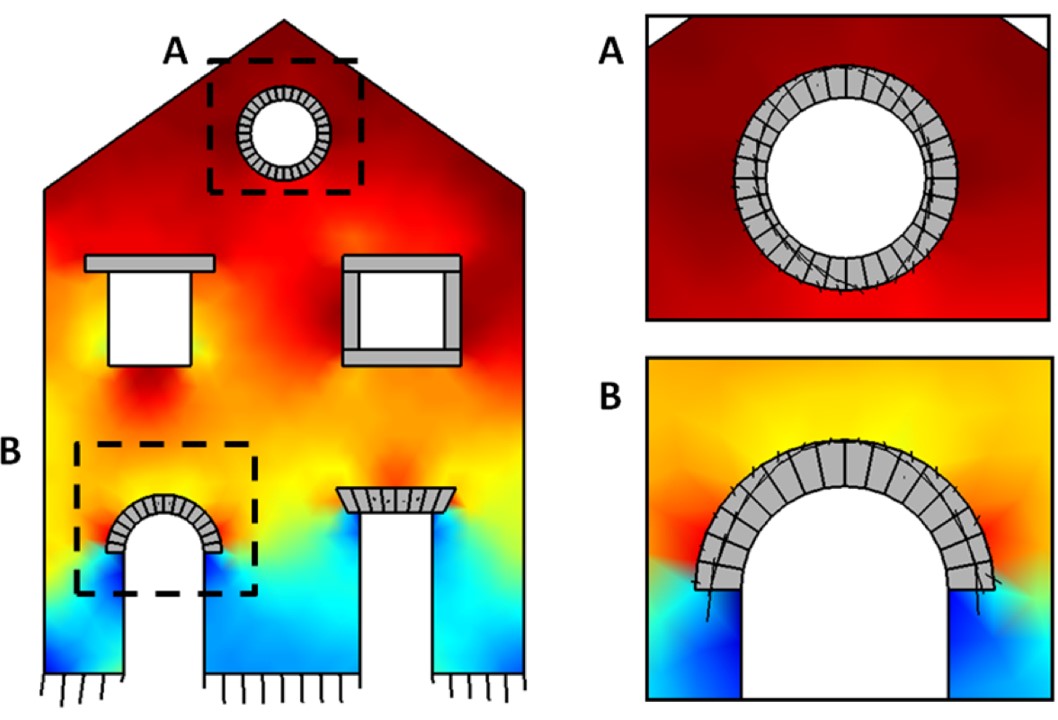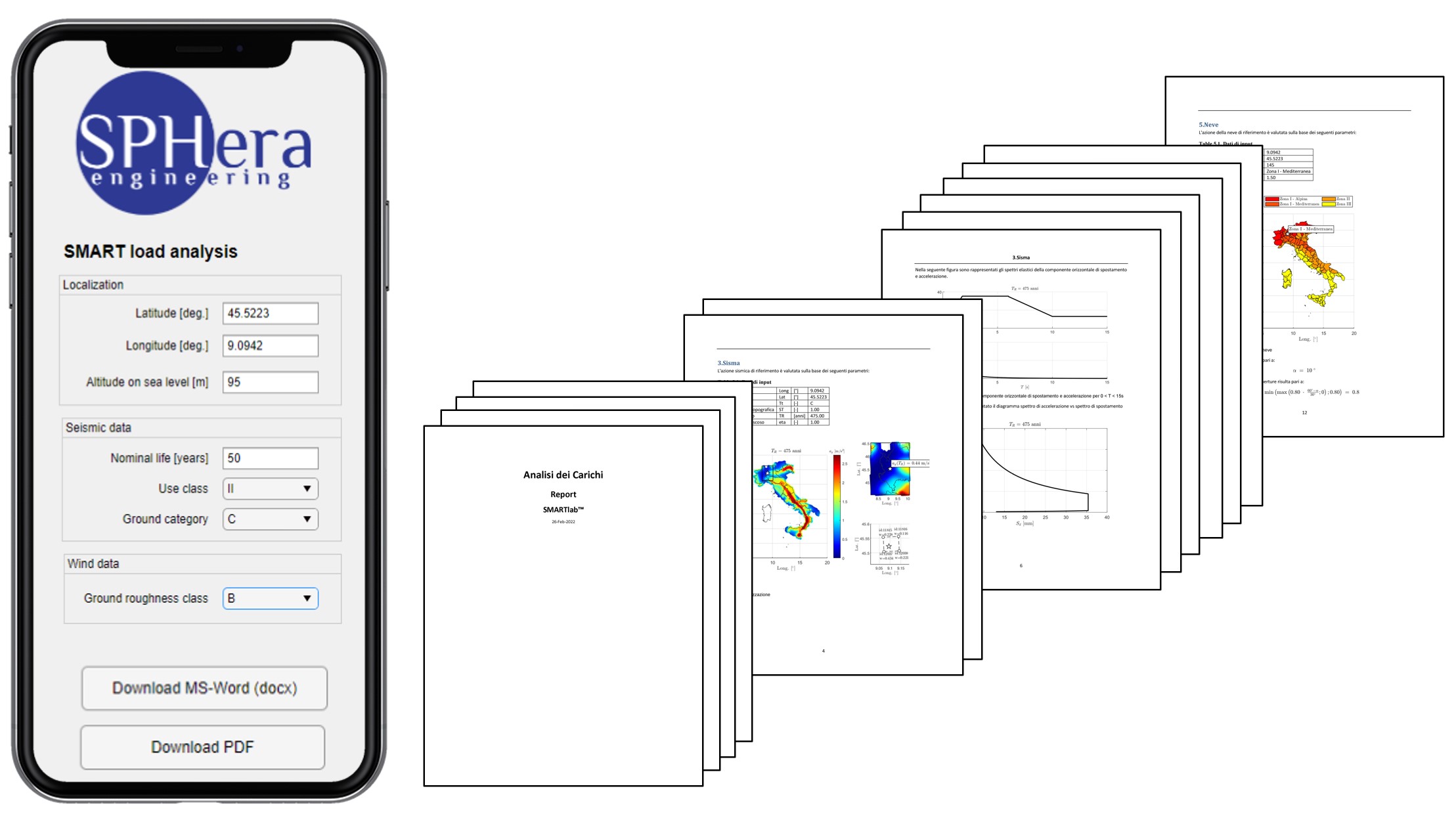Our software department develops bespoke applications to carry out complex calculations in an easy and interactive way: from programs for internal use to customised apps for our clients. These applications are based on research work justified by scientific publications.
SMARTmasonry is a desktop application developed since 2007 for the nonlinear static and dynamic analysis of masonry walls featuring our state-of-the-art hybrid FEM-DEM solver, capable of multi-scale material modeling and a user friendly graphical interface with integrated CAD (since 2011).
Distinct element modelling (DEM) is an efficient choice for structures like cathedrals and for limit analysis.

Our multiscale approach based on a continuum with DEM mesosctructure allows for an accurate modelling of masonry mechanics and efficient computations.

Finally, the hybrid approach allows to treat as an FE-discretized multi-scale continuum the region of the structures where a periodic mesostructure is present (where results are presented in terms of Cauchy stresses), while DEM is used for the regions where the mesostructure is unique like in arches (where results are presented in terms of thrust lines).

The multi-platform GUI features a smart CAD, multiple languages and unit systems, automatic mesh generation and a graphical post-processor.

For standard masonry buildings, seismic vulnerability can be assessed by simpler models such as the equivalent frame model, which is explicitly endorsed by most building codes.
Our implementation includes several unique features coming from scientific research, complience with building standards and is capable of modelling several strenghening techniques.

Static and seismic analysis of rack structures needs to consider several peculiar mechanical features. Uprights are buit by using cold-formed steel. Cross sections are thin-walled (prone to local and distorsional buckling), mono-symmetric (featuring flexural-torsional coupling) and perforated along the whole length; therefore, they require specific threatment. Moreover, joints are based on contact and they exibit peculiar nonlinear moment-rotation response already for serviceability loads; while their cyclic seismic response is characterized by pinching with low energy dissipation. Finally, P-delta effect is critical due to the severe deformability for horizontal loadings and high level of compression of the uprights. All these features, induced us to develop a specific solver feautring co-rotational geometric nonlinearities, specific joints, self-evaluation of the upright interaction domain including local and distorsional bucling as well as plasticity effects and 7-DoF-per-node beam elements for modelling warping.

We developed a prototype desktop application for the design and nonlinear analysis of stratified glass and insulating multi-glazing, according to building codes.
The core of the application uses our finite element solver, featuring geometrically nonlinear shell elements coupled by viscous-elastic interface elements for the PVB layers and a specific nonlinear procedure for the coupling between structural balance and fill-gas state equations.

The graphical user interface shown in the picture below is a Python prototype developed for a client.

We can develop desktop and web applications by using the most recent technologies, including multi-language (and multi-platform, in the case of desktop applications) software. Being structural engineers and having our company a division working in structural design, we are aware of use cases and issues of the strengthening products, as well as a good knowledge of international building standards.
Back in 2009, we developed a simplified equivalent frame solver for masonry structures for the softwarehouse Tecnisoft.


For the Italian Association of Wind Engineering (ANIV) we developed BARC Make Your Own Comparisons, a web application for the analysis of wind tunnel experimental data. The application was developed in MatLab to allow for the addition of future algorithms developed by academic researchers.

In our every-day activity as structural engineers we make use of several in-house developed applications.
An example is our application for the evaluation of snow, wind and seismic actions given the location according to the Italian Building Code.

Mechanical, thermal, and fire analysis of reinforced concrete, FRP strenghening, and composite steel/wood-concrete beam sections is carried out by our finite element application.

Bearing capacity of piles and pile groups, nonlinear analysis of single and double pile walls, and slope stability analysis are some of the geotechnical problems we developed applications for.

Seismic design of new steel-framed openings in existing masonry walls is simplified by our specific interal app, also capable of global sensitivity analyses.

In our curriculum we have multi-physics sophisticated software developed by us that allow us to solve complicated problem in structural analysis, geotechnical engineering, fluid-structure interaction, new materials and composites. We developed and implemented computational models also for:
